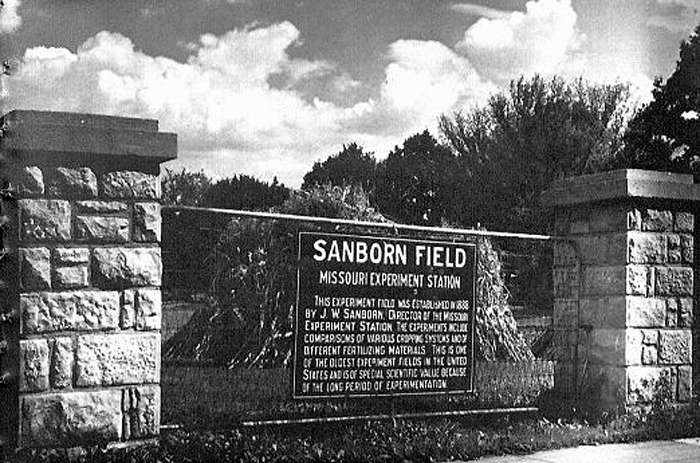
Seventy-five years ago, a life-saving drug made possible by a discovery made on the campus of the University of Missouri in Sanborn Field was created. Since 1949, it has saved countless numbers of human lives and transformed veterinary care for livestock. That discovery was the antibiotic aureomycin, which was produced by a bacterium that lived within the soil of one very specific plot of land in Sanborn. The College of Agriculture, Food and Natural Resources (CAFNR) invites the public to join them for a celebration of this monumental discovery. The anniversary commemoration kicks off the 4th annual CAFNR Research Symposium.
“The incredible discovery of aureomycin in Sanborn Field and the resulting impact on agriculture and human life is a prime example of CAFNR’s rich history of inquiry benefiting not just Missourians, but humanity as a whole,” said CAFNR Vice Chancellor and Dean Christopher Daubert. “I am proud to be a part of the legacy of CAFNR and in leading it into a future filled with more discovery and possibility.”
The event marking the anniversary of aureomycin will take place 8 a.m. to 4:30 p.m., Monday, Sept. 30, in rooms N201 and N214 of Memorial Student Union, and is open to the public. Samiran Banerjee, assistant professor of microbiological sciences at North Dakota State University, will serve as the keynote speaker.
Banerjee is a member of the National Academy of Sciences’ committee on exploring linkages between soil health and human health, and his talk will explore the nexus of soil, animal and human health. His lab explores the effect of intensive management practices on soil- and plant microbiomes in agricultural systems. After receiving his Ph.D. in Soil Science from the University of Saskatchewan, Canada, he worked in Australia and Switzerland before joining the faculty at North Dakota State University.
The CAFNR Research Symposium will follow from 8 a.m. to 5 p.m., Tuesday, Oct. 1, in rooms N201 and N214 of Memorial Union and is organized by the CAFNR Research Council (CRC).
“This year’s symposium will focus on many of the challenges we face in creating a healthy world including weather extremes and the future of agriculture, sustainable and resilient agriculture, water resources and digital agriculture and natural resources,” said Mike Stambaugh, chair of the CRC and professor in the School of Natural Resources.

David Lytle, deputy chief of research and development at the USDA Forest Service, will serve as the keynote speaker of the symposium. As the agency’s leading scientist, he directs, coordinates, and integrates the vast network of all research activities. The agency’s scientific work provides the U.S. with valuable economic, health and environmental benefits through the work achieved by nearly 1,500 employees, including 450 research scientists working in five research stations, two institutes, a network of urban field stations, and on 81 experimental forests and ranges. Prior to his appointment to Research and Development, Lytle served as the Director of Forest Management, Range Management, and Vegetation Ecology for the National Forest System in Washington, D.C. In that role, he led the agency’s efforts to manage 174 national forests and grasslands for sustainable grazing and timber production, the provision of wildlife habitat, clean water, carbon sequestration, species conservation, and a range of other benefits.
“The discovery of aureomycin is one of many highlights of the rich history of research done right here in our college,” said Shibu Jose, CAFNR associate dean of research. “We look forward to exploring this incredible history while sharing how our current faculty and students are ushering us into a healthier world as we look to the future.”
The aureomycin discovery was made in 1945 by William Albrecht and Benjamin Minge Duggar. Duggar was a former botany professor at the University of Missouri working for Lederle Labs in the company’s efforts to compete in the race to find new antibiotics. He requested soil samples from Albrecht, director of Sanborn Field at MU at the time, and Albrecht took the sample from plot 23. He suspected the plot may contain antimicrobial properties. The plot was unique – and of interest — because it had never received any kind of fertility treatments. This remains true today.
Established in 1888, Sanborn Field is the oldest experimental field west of the Mississippi. It is used to study crop rotation and the effects of fertilizers on crops. Plot 23 is home to native Missouri grasses and serves as a control plot for research. Albrecht’s theory was that the lack of any fertility treatments had created a hostile environment in the soil, which is exactly what is needed for an antibiotic to form.
“You’ve heard the expression, ‘walking where giants walked,’? Well, that’s what I tell people it’s like working in Sanborn,” said Tim Reinbott, director of Sanborn Field. Reinbott is charged with overseeing Sanborn Field and has worked in Sanborn for decades.

The resulting antibiotic, the first tetracycline, was a game-changer in human health as it was the first antibiotic that could be taken orally, which meant it could be taken at home. It was the most commonly prescribed antibiotic in both animal and human health for two decades following its discovery.
Today, it is still used to treat respiratory issues in a variety of livestock, and Rocky Mountain Spotted Fever and deep-tissue diseases in humans.
“It’s probably innumerable,” Taylor Nelson, a medical doctor who works with infectious disease at MU Health, said of the number of lives saved by tetracycline. “Even in my career — which has not been extensively long yet — if I think about how many times I have used tetracyclines; I can’t even put a number on it.”
See more information about both CAFNR’s aureomycin discovery celebration and the CAFNR Research Symposium.